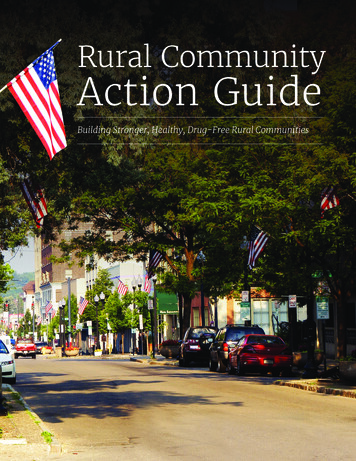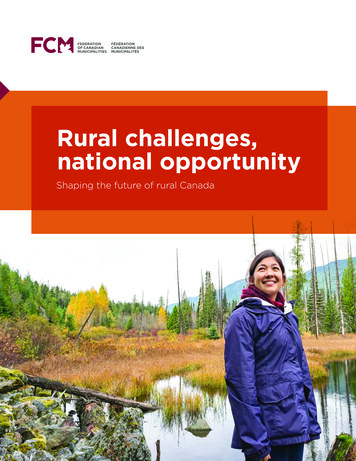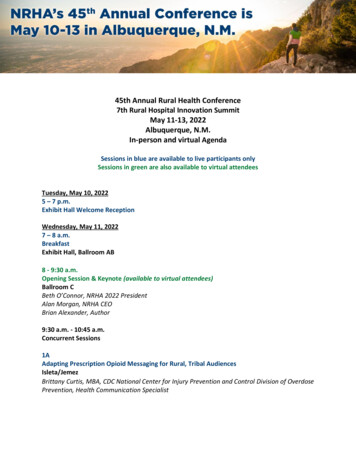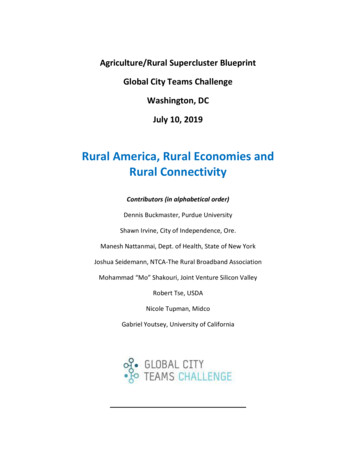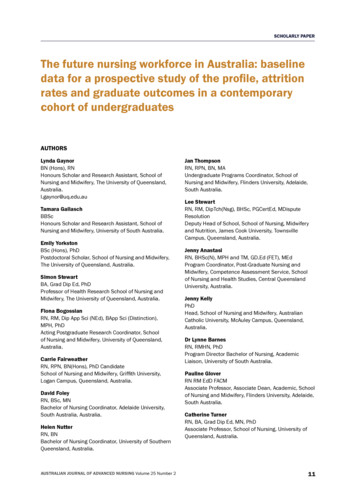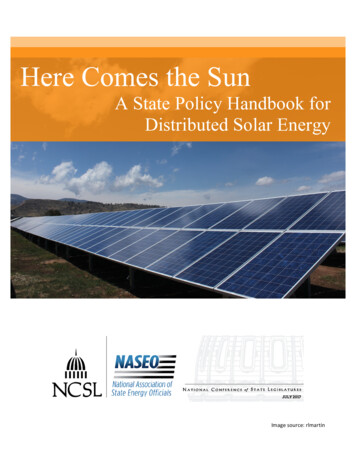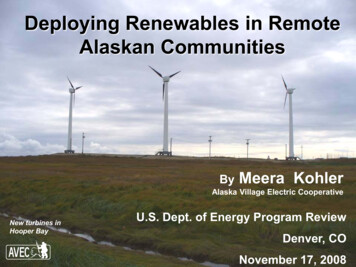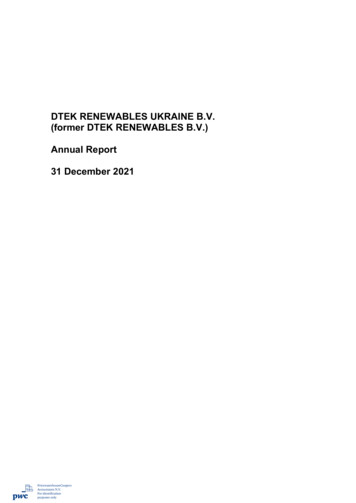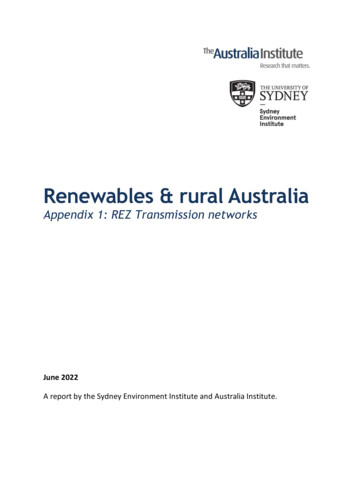
Transcription
Renewables & rural AustraliaAppendix 1: REZ Transmission networksJune 2022A report by the Sydney Environment Institute and Australia Institute.
A.1 CWO REZ AND RE DEVELOPMENT PROFILEThe Central West Orana REZ, chosen for the national pilot REZ, combines two REZcandidates from the 2018 ISP: Central New South Wales Tablelands and Central-West NewSouth Wales.1Distinct to Wellington region is the existing grid connection capacity. There are 66kV,several 132 kV lines and a relatively new 330 kV circuit connection around Wellington,which, in turn, connects to the strong links between the big consumption loads of Sydney,Newcastle and Wollongong and several coal power stations (see Figure A.1 Central Westnetwork) (TransGrid 2020). Currently, six proposed or operational solar and two wind farmsare located near this relatively close connection to the consumption loads of NSW, andtherefore the strong part of the NSW grid. 2 The existing substations, which are most oftenthe connection points to the grid for the wind and solar farms, are marked withblue/red/orange points in the TransGrid network map. The colour of the symbol refers tothe voltage capacity of the substation, which is determined by the overhead line it isconnected to. While the voltage capacity isn’t directly linked to the available capacity of thegrid connection itself, in general “larger” substations have more capacity to start with, andconglomeration of projects especially around Wellington substation would indicateconnection capacity availability.The 330 kV circuit is one of the only options where the main transmission lines towardsSydney are not already congested during peak demand.3 The existing transmission capacityfor hosting new generation was estimated as high as 1000 MW in 2018 ISP (AEMO 2018b, p.18). Even after some projects started construction, it was still estimated in the draft 2020ISP (AEMO 2019b, p. 18) that there was 700 MW capacity left. The situation is rapidlychanging, since Transgrid estimated in 2020 that only 100 MW of spare capacity currentlyremains4 and that the Central West area will also have material congestion problems if allconnection applications are realised (see Table A.1. for capacity estimates).51(2020) 2020 ISP Appendix 5: Renewable Energy Zones, p.11In 2016 Transgrid identified possible new connection points for regional NSW, and the substations withhighest available capacity were Wellington, Tamworth in New England and Darlington Point / Griffith in SouthWest. Of all identified eight locations, Wellington and Tamworth are closest to Sydney, and Wellington is partof recognised renewable energy resources of Central-West area. See tunities%20Fact%20Sheet.pdf3The existing shared transmission capacity between southern NSW and major load centres is heavily utilised attimes of peak demand. See NSW Electricity Strategy (p. 17) and Transgrid (2019, p. etailed%20strategy pdf4Transgrid 2020, New South Wales Transmission Annual Planning t.pdf5The only other area in NSW with similar existing transmission capacity – and recognised renewable energypotential – is the Southern Tablelands area Southern Tableland area has excellent wind resources and hostslarge portion of the existing wind farms in NSW (see Figure X in Chapter 3), but has also significant communityopposition for any new developments, which has been recognised by AEMO (2018b: 20, 2019b, p. 238).2Renewables and Rural Australia2
Figure A.1 : Central West network and indicative Central-West Orana REZSource: TransGrid 2020, p. 28In addition to good grid connection capacity, the existing and forecasted “marginal lossfactors” (MLFs) near Wellington have been comparably low encouraging for newgeneration. MLFs are assigned by AEMO for all generation units inside the NEM and theytypically indicate how much capacity there is in the network (how “congested” it is) andhow favourably generation is located compared to consumption. The MLFs are calculatedyearly and are related to the current open access regime in NEM. Basically, an older projecthas no protection against newcomers in the same connection point, and accumulatingnumber of projects connecting to the same line can impact all the projects negatively bylimiting the amount of usable capacity. For some projects in NSW the credited productionhas been as low as 75–80 % of the actual production (e.g. Broken Hill Solar Farm) (AEMO2019c: 21-23). In Wellington area, however, the MLFs are still manageable and the creditedgeneration is around 95 %6, which generally should not significantly impact the project’sfinancial viability. The uncertainty of long-term production opportunities is a frequentcomplaint of the investors operating in the Australian market (see e.g. Clean Energy Investor6AEMO 2020. Regions and Marginal Loss Factors: FY 2020-21. The MLFs for NSW generators are on pages 18–21. ecurity and reliability/loss factors and regional 20-21-financial-year.pdf?la enRenewables and Rural Australia3
Group’s recent submissions to AEMC)7. The REZ development and the new EII Act aredesigned to address this issue by allowing NSW Government to build more transmissioncapacity, and grant – and importantly also refuse – access to the new infrastructure.A.2 NE REZ AND RE DEVELOPMENT PROFILEAccording to AEMO (2020, p. 24), whereas most of North West NSW is mainly a solar zone,the New England tableland is predominantly a wind zone. Currently, NE REZ has asignificantly smaller existing network capacity compared to CWO REZ. AEMO (2020, 23)estimates only 300 MW of existing usable capacity, that can be potentially upgraded inseveral phases to 5000 MW. Notably, there is already a substantial number of connectionapplications to Transgrid from the larger Northern NSW area, exceeding the possible gridupgrades (see Table A.2 for different capacity and spare network capacity estimates).Similar to CWO REZ, the NSW Government lists good natural resources, investment interestand strong existing grid as reasons for selecting NE REZ. New England also has potential sitesfor pumped hydro development and some proposals have recently received pre-investmentfunding from the Emerging Energy Program (NSW Government 2020). Mount Oven PumpedHydro project is the highest priority energy storage project, designed to support newrenewable generation in the NE REZ with 600MW es/documents/rule change submission - erc0294 clean energy investor group - 20210121.pdfRenewables and Rural Australia4
Figure A.2: New England network and indicative New England REZSource: TransGrid 2020, p. 29The area has several existing high-voltage power lines, which importantly include theexisting QLD-NSW interconnector (QNI) and the plan for the QNI Upgrade between BulliCreek and Bayswater substations (see Figure A.2). While the transmission in the REZ isalready congested towards the main loads (Sydney-Wollongong-Newcastle area)8, there areseveral possibilities to increase the current capacity ranging from virtual transmission withbatteries, technical improvements to existing infrastructure and a new link between Liddelland Tamworth, all considered as a part of the QNI Upgrade (Transgrid 2020). The distance toLiddell and other retiring coal power stations ( the strong links to main loads) from the REZis relatively short and the whole QNI Upgrade has been identified as a committed ISPproject. 9Not surprisingly in New England as in CWO REZ, the built and proposed large-scale projectsare mainly located near the existing grid and substations, which are marked asred/orange/blue dots in Figure A.2. The size of the projects is somewhat larger compared toCWO REZ, though there are also some mid-scale solar projects (5-25 MW) planned oralready built.A.3 ESTIMATES OF NEW GENERATION CAPACITY: CWO AND NE REZREZ resource estimates, network capacity estimates and statistics of different agencies atdifferent times vary as the tables below show. Estimates seem to trend upwards over time,and the most recent projections from TransGrid’s 2020 connection applications for CWOREZ show the existing projects, though some still in very early stages of planning, alreadyexceed most estimates.Table A.1. Estimate of new generation capacity (Central West Orana)AEMO 2018 ISP - Spare network capacityCentral West: 100 MWCentral NSW Tablelands: 1000 MWAEMO 2018 ISPEstimated resourcesNote: Central West Orana is partly on twoseparate REZs in 2018 ISP; Central West andCentral NSW TablelandsCentral West:Solar: 3750 MW (C)Wind: 1420 MW (C)Central NSW Tablelands:Solar: 3000 MW (D)Wind: 1600 MW (B)8See NSW Electricity Strategy (p. 17) iled%20strategy 0.pdf9The other link to Queensland shown on Figure A.2, Directlink ,is a privately funded 180MW transmission lineowned by a transnational energy investment company, Energy Infrastructure Investments Pty y%20-%20January%202019.pdf )Renewables and Rural Australia5
AEMO 2020 ISPNetwork capacity considerationsAEMO 2020 ISPEstimated resourcesNSW Government 2018 REZ planTransgrid 2020 connection applications(“Central NSW”)Transgrid 2020 available capacity outsidealready signed connection agreements 3000 MW (by 2022)Solar: 7200 MW (C)Wind: 3000 MW (C) 3000 MW (goal by mid 20s)Solar: 9095 MWWind: 3895 MWBattery storage: 1800 MW100 MWTable A.2. Estimate of new generation capacity (New England)300 MW (called Northern NSWAEMO 2018 ISP - Spare network capacityTablelands REZ)AEMO 2018 ISPEstimated resourcesSolar: 1750 MW (D)Wind 3660 MW (B)AEMO 2020 ISPNetwork capacity considerationsStage 1: 3000–4000 MWStage 2: 4000–5000 MWAEMO 2020 ISPEstimated resourcesSolar: 3500 MW (C)Wind 7400 MW (C)NSW Government REZ plan 8000 MW (no timeframe yet)Solar: 8190 MWWind: 4612 MWHydro: 600 MWTransgrid 2020 connection applications(“Northern NSW”)Transgrid 2020 available capacity forNorthern NSW outside already signedconnection agreementsRenewables and Rural Australia400 MW6
for hosting new generation was estimated as high as 1000 MW in 2018 ISP (AEMO 2018b, p. 18). Even after some projects started construction, it was still estimated in the draft 2020 . (2020) 2020 ISP Appendix 5: Renewable Energy Zones, p.11 . Microsoft Word - P1176 Renewables and Rural Australia appendix 1 [WEB].docx Created Date:
